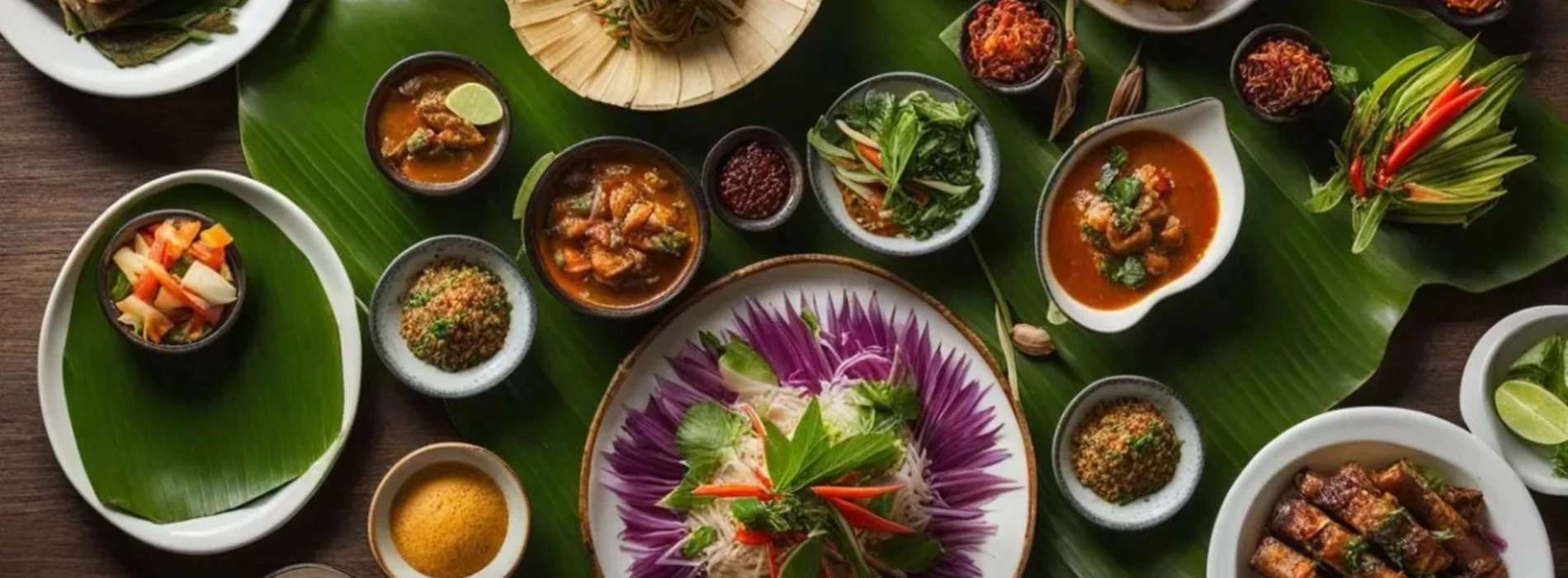
Cambodian cuisine, or Khmer cuisine, features balanced flavors and fresh ingredients - milder than Thai food. Not a fan of spice? Don’t worry! This guide will help you explore Cambodia’s delicious dishes with ease. Join Asia King Travel to enjoy Cambodian cuisine your way!
.jpg)
Khmer cuisine - is known for its balanced flavors and fresh ingredients.
The short answer is: Not all Cambodian dishes are spicy - in fact, Khmer cuisine is generally milder compared to Thai food or some central Vietnamese dishes. Instead of using chili as a main ingredient and mixing it directly into the food like in Thai cooking, Cambodians often serve chilies on the side or as part of dipping sauces, allowing diners to adjust the heat level to their own taste.
When present, the spiciness typically comes from:
Interestingly, spiciness is not the focal point in Khmer cuisine. The Khmer people prefer a balanced harmony of flavors – sweet, sour, salty, bitter, and just a hint of spice.
.jpg)
Not all Cambodian dishes are spicy
One of the standout features of Cambodian cuisine is its subtle combination of natural ingredients, creating a pleasant and easy-to-enjoy experience - even for those unaccustomed to spicy food.
Here are the key flavor profiles often found in Khmer dishes:
Compared to the bold intensity of Thai dishes or the contrasting tastes in Vietnamese cuisine, Khmer food leans toward a lighter, more refined balance - making it not only flavorful but also gentle on the stomach.
.jpg)
Cambodian cuisine is its subtle combination of natural ingredients
You may like: Cambodian Street Food - Culinary Culture
If you’re wondering what dishes to try in Cambodia without the risk of “burning your tongue,” here’s a list of popular Khmer dishes along with their typical spice levels:
Considered Cambodia’s national dish, Amok Trey features fish gently steamed in banana leaves, offering a rich yet delicate flavor and an irresistible aroma. The fish is marinated with coconut milk, turmeric, lemongrass, and other traditional spices, then steamed until tender. This dish contains no spiciness at all, making it perfect for children and anyone sensitive to heat.
.jpg)
Amok Trey
Lok Lak is a popular Cambodian dish made of stir-fried beef in black pepper sauce, typically served with steamed rice, a fried egg, tomatoes, and fresh lettuce. The beef is tender and flavorful, with a rich, peppery aroma. The mild heat comes from black pepper, adding a gentle kick without being overwhelming - ideal for those who prefer only a touch of spice.
.jpg)
Lok Lak
Unlike the famously fiery Thai red curry, the Khmer version is much milder. Made with coconut milk, lemongrass, turmeric, sweet potatoes, green beans, and often chicken or beef, this curry offers a warm, comforting flavor with just a hint of spice. It’s aromatic, creamy, and suitable even for those who aren’t fans of spicy food.
.jpg)
Khmer Red Curry
Samlor Korko is a classic Khmer soup made with a variety of local vegetables like loofah, eggplant, green banana, and pumpkin, often simmered with prahok (fermented fish paste) and sometimes meat or fish. Mild spiciness is added through chili or pepper, but the overall taste is gentle, emphasizing the natural sweetness and richness of the vegetables.
.jpg)
Samlor Korko
Bai Sach Chrouk, a popular Cambodian breakfast dish, is made of sweet-marinated grilled pork, that goes well with steamed rice, fresh cucumber, herbs and dipping sauce. It’s entirely non-spicy and very gentle on the stomach, so it’s great for kids of all ages and also a perfect option for a light but still filling morning meal.
.jpg)
Bai Sach Chrouk
Larb Khmer is a zesty minced meat salad tossed with fresh herbs, lime juice, onions, and chopped chilies. Known for its bold sweet-sour-salty-spicy balance, this dish delivers a flavorful punch. The spice level can be adjusted upon request, so if you’re not used to heat, feel free to ask for less or no chili. For spice lovers, this dish is a must-try.
.jpg)
Larb Khmer
You may like: Top 5 Cambodia Tours 5 Days: A Journey for Every Travel Style
Cambodian cuisine is known for its balance and subtlety, but some dishes can still pack a bit of heat. Luckily, Cambodian people are warm and accommodating - and they understand that not everyone can handle spicy food. Here are a few tips to help you enjoy your culinary journey without those unexpected “chili tears”:
.jpg)
Cambodian cuisine is known for its balance and subtlety
If you have the chance to visit Cambodia, don’t limit yourself to upscale restaurants - make time to explore local markets and street food stalls. These are the best places to truly feel the warmth and authenticity of Khmer hospitality, and to taste the real flavors of Cambodian cuisine. Here are a few recommendations:
These experiences will not only delight your taste buds but also connect you more deeply with local culture.
.jpg)
Suggested Khmer Culinary Experiences When Traveling in Cambodia
Cambodian cuisine offers a harmonious blend of distinct yet gentle flavors, making it easily approachable - even for those who can’t handle spicy food. From the rich, creamy Amok to the humble grilled pork with rice, each dish reflects the unique Khmer culture and is kind to the taste buds.
So if you’ve ever hesitated out of fear of spicy food, rest assured: Cambodian cuisine welcomes you with its subtlety, balance, and cultural richness. Join Asia King Travel and discover Khmer cuisine your own way - flavorful, authentic, and wonderfully mild!
You may like: Cambodia Travel FAQs: Clear up your doubts when traveling in Cambodia